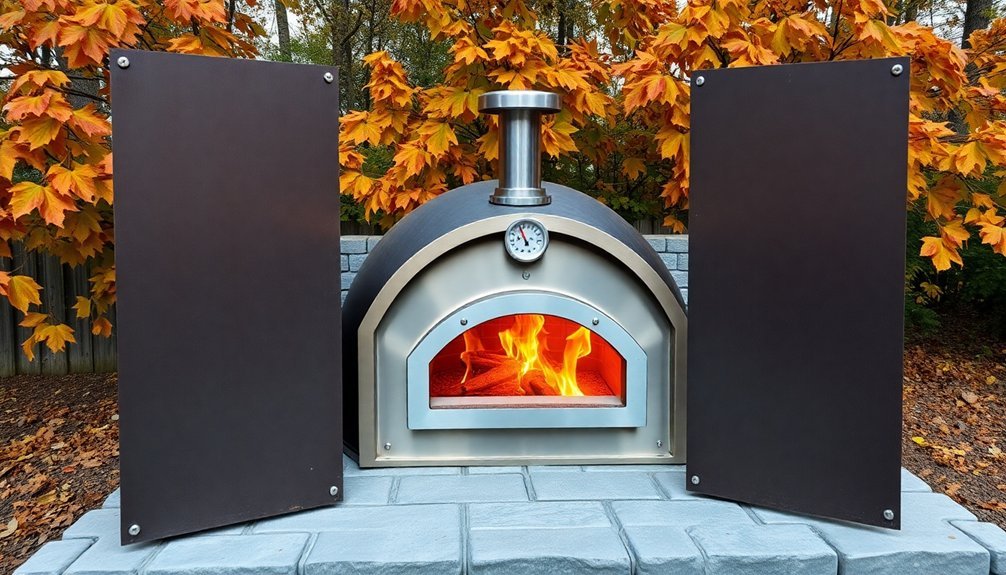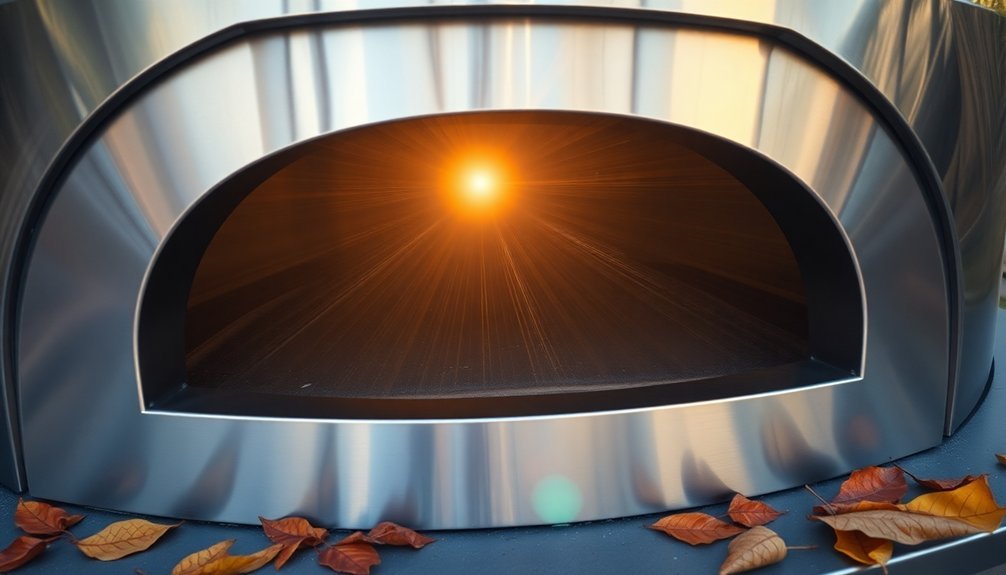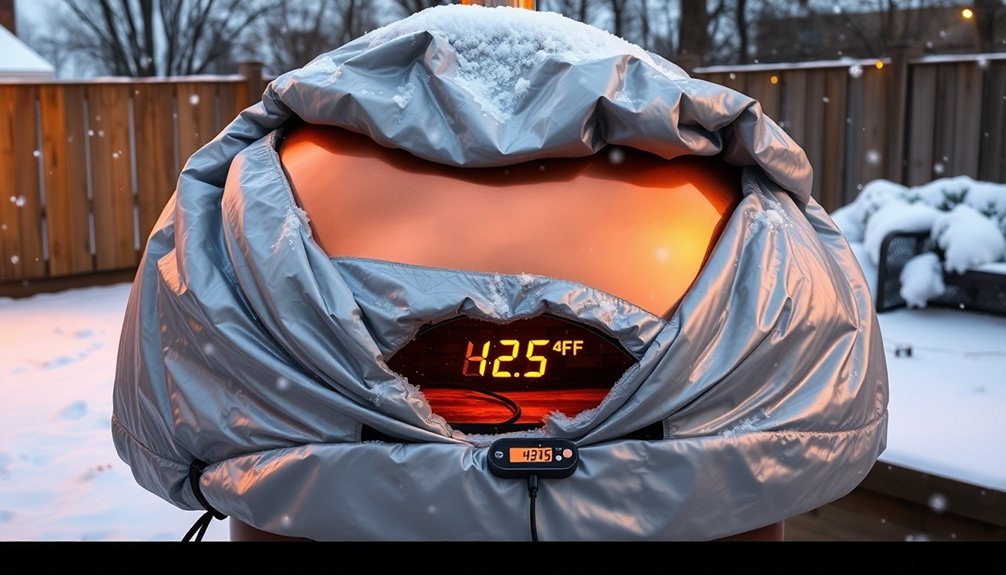To effectively preheat your outdoor oven while protecting it from wind, you'll want to implement five proven methods. Start by installing a sturdy windbreak barrier using commercial guards or DIY shields. Position your oven strategically with its back facing prevailing winds while maintaining proper airflow. Add a double-wall heat shield with ceramic insulation for superior heat retention. Use natural landscape features like trees and shrubs as living windbreaks. Finally, wrap your oven with a thermal blanket for ideal temperature control. These techniques will maximize your oven's efficiency and minimize fuel waste – and there's even more to explore about perfecting your outdoor cooking setup.
Windbreak Barrier Setup

When setting up a windbreak barrier for your outdoor oven, you'll need to choose between commercial and DIY solutions based on your specific needs.
For a portable option, consider foldable wind guards made of aluminum or stainless steel, or create your own using plywood or cardboard arranged in a three-sided shield. Installing high-temperature silicone around the edges of your windbreak helps create an additional seal against wind infiltration.
For permanent protection, you can install a dedicated grill shelter or build a rustic brick windscreen.
Position your barrier perpendicular to prevailing winds and guarantee it extends beyond your cooking area to prevent wind eddies.
If you're using a wall or fence as a natural windbreak, maintain adequate space for ventilation.
Remember to secure your barrier firmly to the ground and keep the front open for easy access.
Regular maintenance will keep your windbreak effective and long-lasting.
Strategic Oven Positioning
Proper positioning of your outdoor oven can make the difference between ideal cooking performance and frustrating heat loss.
You'll want to angle your oven so the wind crosses the front opening rather than hitting it directly, which helps maintain stable internal temperatures even in winds up to 25 mph.
If you're in an area with constant high winds, consider positioning the oven's back toward the prevailing wind direction. The oven's body will act as a natural windbreak, protecting the essential front opening. Regular maintenance checks may be required when installing ovens in areas with persistent high winds.
Don't let wind protection completely dictate placement, though – you'll still want your oven to complement your backyard's layout and aesthetics.
Surprisingly, a light breeze can actually improve your oven's performance by providing fresh oxygen for a hotter, fuller fire.
The key is finding the right balance between protection and airflow.
Double-Wall Heat Shield Method

Building on smart positioning, a double-wall heat shield method takes your outdoor oven's protection to the next level.
You'll want to install specialized insulation like DoubleDown Ceramic Superwool® between the walls, which provides twice the heat resistance of standard stone wool.
The OptiDome design's flattened semi-sphere shape, combined with the Full Effect Full Circulation Flue System®, guarantees hot air moves efficiently throughout your cooking chamber.
This design pushes heat downward to warm the refractory stone while maintaining consistent temperatures. The HeatKeeper™ Refractory Stone absorbs and retains heat more effectively than traditional lava stone or ceramic materials.
When you open the door, a special heat deflector guides the warmth upward toward the flue.
You'll benefit from quick heating times, improved fuel efficiency, and better temperature control.
The double-wall vent maintains safe distances to combustibles while preventing heat loss through proper insulation.
Natural Landscape Protection Techniques
To maximize your outdoor oven's performance, strategic use of natural landscape features can provide superior wind protection while preserving the surrounding environment.
You'll want to integrate conservation-minded approaches that protect both your cooking area and local ecosystems. Consider planting native trees and shrubs as natural windbreaks, which will also support local biodiversity and improve soil stability.
- Create living windbreaks using indigenous plants that match your area's historical landscape
- Position your oven near existing natural formations that offer wind protection while preserving scenic views
- Incorporate conservation easement principles when planning your outdoor kitchen space
- Use native ground cover to prevent soil erosion around your cooking area
- Maintain existing vegetation patterns to protect local wildlife habitats while shielding your oven
Thermal Blanket Shielding

Effective thermal blanket shielding revolutionizes outdoor oven performance through superior insulation and heat retention.
You'll find that ceramic fiber blankets, which withstand temperatures up to 2300°F, are your best choice for reliable protection.
Installing thermal blankets is straightforward – you can cut and shape them easily with a knife, typically completing the process in under 30 minutes.
Two layers usually provide sufficient insulation, though you can add more for colder climates.
You'll notice immediate benefits: faster heating times, consistent temperature distribution, and reduced wood consumption.
The blankets mold perfectly around your oven's shape while keeping the exterior cool to touch.
They're cost-effective compared to additional fire brick and support various finishing options like brick, stone veneer, or tile.
Best of all, they'll maintain your oven's performance regardless of weather conditions.
Frequently Asked Questions
How Long Should I Wait Before Adding Pizza After Reaching Target Temperature?
You'll want to wait 5-10 minutes after reaching target temperature. This allows heat to distribute evenly across the pizza stone. Once the flames die down and embers settle, you're ready to add your pizza.
Can I Use Chemical Fire Starters When Preheating in Windy Conditions?
You can use chemical fire starters in windy conditions, but you'll need to protect the flame initially. They're effective and safe when properly sheltered, though you should check local regulations first.
Does Paint Color of Outdoor Oven Affect Heat Retention During Preheating?
Yes, your oven's paint color remarkably affects heat retention. Dark colors absorb 70-90% of radiant heat, helping maintain temperature during preheating. You'll get better heat retention with darker painted surfaces than light ones.
Should I Remove Ash Between Preheating Sessions on Windy Days?
You don't need to remove ash between preheating sessions on windy days. Instead, push it to one side with a copper brush. The ash can actually help maintain heat and protect your fire.
What's the Maximum Wind Speed at Which Preheating Remains Effective?
You'll find preheating remains effective up to 15-20 mph winds. Beyond that, you're fighting heat loss and unstable flames. If you've got proper wind barriers, you might push it to 25 mph.
In Summary
You'll find these five wind protection methods essential for maintaining consistent temperatures in your outdoor oven. Whether you're using a windbreak barrier, positioning your oven strategically, installing heat shields, taking advantage of natural landscapes, or employing thermal blankets, you're now equipped to combat gusty conditions. Don't let wind interfere with your outdoor cooking – put these techniques to work and enjoy reliable preheating every time.





Leave a Reply